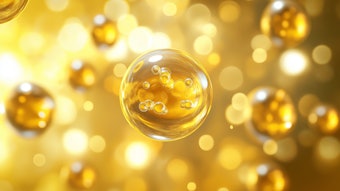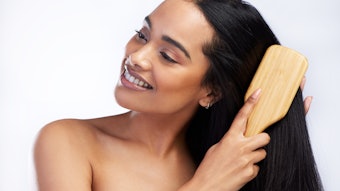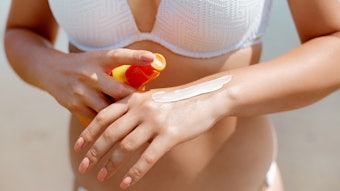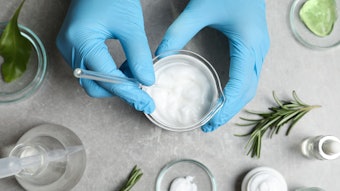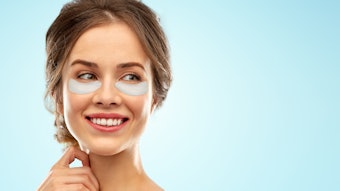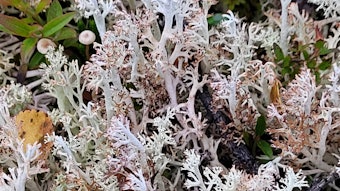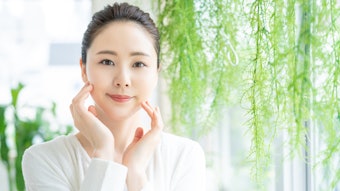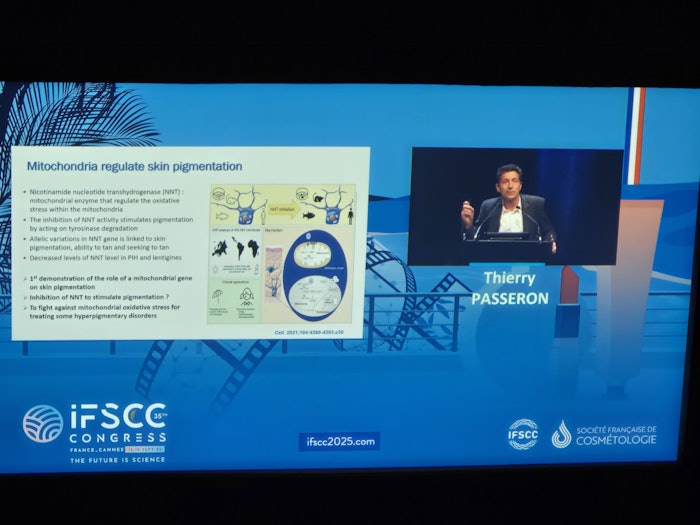
The IFSCC 2025 Congress explored the evolving landscape of cosmetic science with Day One's focus on skin and hair health and well-being. Conference topics ranged from UV and photoprotection, fundamentals for skin health (including cleansing and moisturization) and the neuroscience of emotion, to the effects of the exposome on skin, and the impact of stress on hair.
Overall, the day's conference program demonstrated how cosmetics are redefining the synergy between inner health and outer beauty, positioning cosmetics as essential components of holistic wellness.
In addition, an innovation exhibition, extensive poster session (600+), L'Oreal's Sustainability Challenge and Helena Rubinstein's "satellite" conference examining ozone as the next frontier in skin stress rounded fill the remainder of attendees' schedule openings — and after a day of heavy-hitting science, attendees retreated to the fabulous Parc de Mougin for a night of networking, food and fun, sponsored by LVMH.
Keynotes Highlight Future of UV Protection, Personal Care as an Everyday Essential, and the Neuroscience of Emotion
Mitochondria Regulation of Pigmentation, Non-filtering Photoprotective Ingredients and Topical Silk Inhibitors
Prof. Thierry Passeron, M.D., Ph.D, head of dermatology at the University Hospital of Nice, addressed UV-induced skin damage across UVB, UVA and visible light spectrums. He examined wavelength-specific cellular and clinical damage mechanisms and discussed tailored photoprotection strategies based on skin type and geographical factors.
Besides UV, "we must take the exposome into consideration," he said, illustrating how animals such as sea snakes have been shown, in polluted habitats, to become darker, nearly losing their lighter stripes. In humans, he added, "it's been shown that the more you're exposed to soot, the more you develop pigmentation — and wrinkles."
According to Passerson, mictochondria regulate skin pigmentation. More specifically, variations in the NNT gene (nicotinamide nucleotide transhydrogenase) are linked to skin pigmentation and the ability to tan.
Other components in skin protection, per Passerson, are the skin microbiome and the need to adapt tinted skin protection products to match varied skin tones.
In terms of solutions, he proposed non-filtering photoprotective ingredients (PINGs), which can reportedly extend the efficacy of conventional sunscreens and fill in their shortcomings, such as wavelength limitations and environmental impact. "[However], these must be an add-on to existing filters," he emphasized.
One "exciting" ingredient with great skin protection potential, according to Passerson, is topical silk inhibitors. He explained how they have been shown in vivo to increase DNA repair, remove DNA damage and decrease MMP1 activation after UV exposure.
Lastly, he pointed to the opportunity for personalized photoprotection based on patient history, genetic markers, UVA, UVB, visible and infrared exposure, and other environmental sensors including diet, sleep, exercise, microbiome, skin phototype and more.
The Essential Role of Personal Care Technology: The 'Humble' Moisturizer
 Keynote speaker Paul Matts, Ph.D., distinguished Fellow, retired R&D vice president of P&G, presented an "Out of the Box" session on more than mere moisturization, but the essential need for cleansing and care ingredients.
Keynote speaker Paul Matts, Ph.D., distinguished Fellow, retired R&D vice president of P&G, presented an "Out of the Box" session on more than mere moisturization, but the essential need for cleansing and care ingredients.
Keynote speaker Paul Matts, Ph.D., distinguished Fellow, retired R&D vice president of P&G, presented an "Out of the Box" session on more than mere moisturization, but the essential need for cleansing and care ingredients.
He highlighted how skin is often viewed and treated "like meat," but it is the membrane that separates us "against the chaos of universal entropy," and deserves to be treated like a membrane. He added that, in the context of advanced skin and hair care treatments, basic moisturizers "fall to the bottom of the pile — but they are profoundly more important."
After setting this framework, he showed sobering case studies from Ethiopia and Tanzania of poverty-stricken individuals living in poor conditions and suffering from podoconiosis (aka podo), a non-infectious leg swelling (lymphedema) caused by long-term exposure of bare feet to irritant soils.
After sorting through issues of social stigma and educating about the use of precious water for cleansing, Matts demonstrated how water, soap and petrolatum, followed by protective customized shoes as a "second skin," could reverse the condition, giving individuals new hope.
Taken together, the presentation revealed evidence-based efficacy in resource-poor settings and the profound impact of fundamental cosmetic formulations.
Neuroscience of Emotion: Bridging Beauty and Brain Science
 David Sander, Ph.D., professor in the department of psychology, FPSE, at the University of Geneva Swiss Center for Affective Sciences, gave a comprehensive exploration of affective neuroscience.
David Sander, Ph.D., professor in the department of psychology, FPSE, at the University of Geneva Swiss Center for Affective Sciences, gave a comprehensive exploration of affective neuroscience.
David Sander, Ph.D., professor in the department of psychology, FPSE, at the University of Geneva Swiss Center for Affective Sciences, then gave a keynote providing a comprehensive exploration of affective neuroscience.
He opened with a demonstration of the subjectivity of emotion by asking attendees to define what an emotion is; this proved difficult. Sander laid the groundwork for the discussion with background on the neuroimaging of the central and peripheral systems (e.g., electromyography, electro encephalography or EEG and functional magnetic resonance imaging or FMRI), which have become central to our understanding of emotions.
According to Sander, the main components of emotion include:
- the event,
- the autonomic response,
- action tendencies,
- expression and
- feelings,
all of which are shaped by an individual's concerns and goals, and in the end lead to the elicitation of emotion.
He then introduced a multi-component emotion model, demonstrating how this process to elicit emotion is further influenced by one's attention, memory and learning, and decision-making. By adding factors such as a pleasant olfactory stimuli into the process (i.e., panelists enjoying the scent of chocolate), or extending this stimuli to panelists eating chocolate to the point of having "had enough," (i.e., the scent was less pleasurable), he illustrated the complexity of emotion.
Considering the industry's current focus on wellness and emotion, these insights could have implications for neurocosmetic applications.
Technical Sessions: Advanced Research and Development
Beyond the keynote presentations, Day One of the IFSCC 2025 Congress dove deeply into technical sessions on photoprotection, skin health and more. Following is an overview.
Session 1: Photoprotection Innovations
- Novel anti-hyperpigmentation research: Functional analysis of sFRP1 in solar lentigo formation through dermal fibroblast senescence mechanisms
- Advanced testing methodologies: Critical evaluation of the ISO 23675:2024 "Double Plate" in vitro SPF testing protocol
Session 2: Health-focused Formulation Science
- Lipid research: Comprehensive analysis of unsaturated fatty acids and saturated oils' effects on oily skin conditions
- Atopic dermatitis advances: Multiscale ceramide alteration analysis highlighting enzymatic treatment targets
Session 3: Safety and Efficacy Validation
- Hydrogen gas applications: Novel hydrogen-releasing film technology for UV damage recovery and wrinkle reduction
- Infrared protection: Cold infrared (IRA) and mechanisms of IRA-induced damage to fibroblasts and keratinocytes and functional liposome-based photoprotection methods
- Next-gen risk assessment:
Session 4: Dermatological Health Solutions
- Skin nanotexture biometrics applications: Deep learning approach for atopic dermatitis severity quantification across Fitzpatrick skin types
- Neuro-inflammatory response: Bacterial-induced responses in novel keratinocyte and sensory neuron models
- Green technology: Multifunctional nanozyme applications in skin care formulations
 During the IFSCC Congress, a parallel innovation exhibition and extensive poster session (600+) filled attendees' empty calendar slots.
During the IFSCC Congress, a parallel innovation exhibition and extensive poster session (600+) filled attendees' empty calendar slots.
Specialized Focus Areas: Emerging Science Applications
Special focus areas in emerging areas included the following.
Neurocosmetics and Sensory Sciences
- Neuro-aging and sensitivity connections: Correlation between neurological aging processes and skin sensitivity development
- Stress-beauty interface: Brain function's role in stress, inflammation and emotional well-being
- Sensory response analysis: EEG and ECG-based evaluation of essential oil relaxation effects
- AI-driven innovation: Machine learning applications in peptide design for MMP1 inhibition
- Skin-on-a-chip model: Innervated chip to study neurovascular interactions
- Muscle relaxation-like effects: Insights on relaxation and well-being mechanisms from neurocosmetic studies
- Effects of biomarker depths: A study of differences in internal biomarkers on related external skin markers
Exposome and Environmental Stress Research
- Senescent cell biology: Lipid aldehyde effects on extracellular matrix and senescence propagation
- Chronic stress management: 3D skin equivalent models for stress-induced conditions using ectoin
- Novel inflammaging target: Blocking HMGB1 through computationally designed cyclic peptide
- Adrenergic receptor targeting: β2-adrenergic receptor modulation for psychological stress-induced aging prevention
Hair Science Innovations
- Organoid technology: Human hair-bearing organoids for stress-induced greying studies
- Natural active development: Helichrysum italicum essential oil's IGF-1 signaling enhancement for hair growth
- Recombinant protein applications: Filaggrin 2's ameliorative effects on DHT-induced damage in dermal papilla cells
Industry Integration: Sustainability and Innovation
Finally, two specialized sessions filled out the program: L'Oreal's Sustainability Challenge and the Helena Rubinstein "Satellite Symposium" on the next frontier for skin protection: ozone.
L'Oreal's Sustainability Challenge
 Hosted by Société Française de Cosmétologie (SFC) with L'Oréal Research and Innovation support, the Sustainability Challenge featured eight finalists who were selected for technologies related to sustainable sourcing, green formulating and more.
Hosted by Société Française de Cosmétologie (SFC) with L'Oréal Research and Innovation support, the Sustainability Challenge featured eight finalists who were selected for technologies related to sustainable sourcing, green formulating and more.
Hosted by Société Française de Cosmétologie (SFC) with L'Oréal Research and Innovation support, the Sustainability Challenge featured eight finalists who were selected for technologies related to sustainable sourcing, green formulating and more.
Finalists included:
- Bioweg, which offers a surface-treated functionalized bacterial cellulose as a replacement for microplastics and acrylic polymers;
- Brilliant Dyes, offering sustainable natural dyes derived from algae thanks to a closed loop development process, ultimately designed to replace synthetic dyes;
- Constance Health, which grows traditional medicinal plants (e.g., Portulaca oleracea L.) hydroponically and without contaminants for pure ingredients to treat conditions such as eczema;
- Deep Blue Biotech (winner), whose technology "harnesses the planet's oldest photosynthetic life" (e.g., sand bacteria), turning CO₂ into high value molecules to create bioactives such as hyaluronic acid;
- Future Gaia, which sustainably scales up of wild plants (Arnica montana) in native soil conditions to ensure holistic reproduction;
- NoPalm Ingredients, which offers palm oil equivalents derived through fermentation with bacteria fed by food waste;
- Seprify, which, inspired by nature's brightest white-colored beetle, replicates this pigment for high light-scattering capability, resulting in the company's SilvaLuma 100% natural SPF booster; and
- Sunthetics, which offers a process to help optimize every decision in the development of a product's sensorial characteristics to ensure the highest sustainability.
'Satellite' Symposium: Ozone Protection
The Helena Rubinstein "satellite" symposium, held alongside the main conference talks, on Day One, focused on ozone as the new frontier in skin stress. Professor Philippe Fossati, of the Institute of Cerveau, introduced the impact of stress on the brain and body. Following which, Audrey Gueniche, Ph.D., of Helena Rubinstein, described how these effects cascade via the skin-brain axis. She additionally delves into the rising relevance of ozone as an inflammatory skin stressor and offers a solution powered by Crithmum maritimum native cells to protect skin.
 After a day of heavy-hitting science, attendees retreated to the fabulous Parc de Mougin for a night of networking, food and fun, sponsored by LVMH.
After a day of heavy-hitting science, attendees retreated to the fabulous Parc de Mougin for a night of networking, food and fun, sponsored by LVMH.


